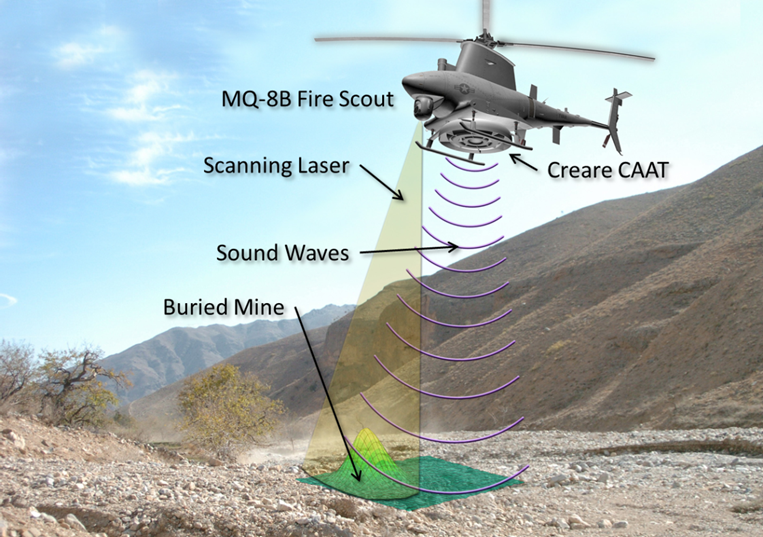Hunting Landmines with Sound
Landmines and buried IEDs are a real and constant danger to U.S. warfighters in modern conflict zones. These threats persist for decades after the fighting subsides, killing or maiming thousands of civilians (often children) each year. Detecting buried threats safely and remotely from the air can reduce both military and civilian casualties while improving troop mobility. Coupled acoustic-optical techniques are promising at both detecting and discriminating buried targets: sound waves shake the ground and excite responses in buried landmines that can be detected with a scanning laser vibrometer.

Creare’s Compact Airborne Acoustic Transmitter (CAAT) shakes the ground using sound waves; this shaking excites responses in buried landmines that can be detected with laser-based detectors.
The Navy is interested in mounting this system on an unmanned helicopter to enable rapid deployment, quick survey times, and near-complete safety for the soldiers involved. Creare is developing a Compact Airborne Acoustic Transmitter (CAAT) – a lightweight and highly efficient sound source – to generate the high-intensity, low-frequency sound waves necessary to sufficiently shake the ground from altitudes of up to 2,000 feet above ground. Our first-generation prototype met or exceeded the Navy’s specifications on size, weight, power, and performance. We are currently working on a second-generation device that reduces the system weight by over a factor of two – enabling deployment on a wider variety of unmanned aircraft.
Success of the CAAT hinges on the novel geometry of the acoustic horn coupling its sound source to the environment. We modeled and optimized the horn shape using finite element methods and manufactured a prototype out of high-strength materials. We then tested the prototype at full power in a custom-built concrete facility at Creare and at reduced power suspended from a construction crane. Airborne testing from a helicopter is planned during a follow-on effort.
Jed Wilbur has an M.S. from Boston University where he studied underwater sound propagation. He also has B.S. and A.B. degrees from Lafayette College. Jed’s work at Creare focuses on acoustics, with projects on improved biomedical and industrial ultrasound imaging, hearing protection for extreme noise, functional hearing assessment, and novel communication systems.
This story was featured in the Fall 2016 edition of Creare’s People & Technology newsletter.
